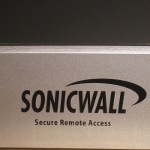 The Sonicwall SRA (Secure Remote Access) 1200 is solidly built. The unit is not one of those lightweight plastic-clad units that will break the first time it is treated harshly. The SRA 1200 that was tested and reviewed came equipped with 2 network interfaces, 2 USB ports, and one console port.
The Sonicwall SRA (Secure Remote Access) 1200 is solidly built. The unit is not one of those lightweight plastic-clad units that will break the first time it is treated harshly. The SRA 1200 that was tested and reviewed came equipped with 2 network interfaces, 2 USB ports, and one console port.
It was easy to setup and connect to the management using a web browser. The unit supports Windows, Mac, or Linux, and web browsers that are supported on these operating systems. I used a Linux OS and Firefox web browser to configure the SRA 1200 unit. The only issue I ran into during the setup process was, in connecting to the management interface, the computer’s NIC (network card) had to first be set to a static IP. Since the instructions included with the unit give very good guidance on how to do this and what IP to use, you should not have a problem with this issue as long as you follow them.
When I connected to the SRA 1200 using the management interface, it defaulted to a HTTPS (secure) connection using the unit’s default self-signed certificate. Because I am a security and tech guy, it is nice to see a product that defaults to secure settings. With this said, you will need to add an exception to the browser’s SSL certificate settings since the self-signed certificate is the only certificate on the unit when you first start it. You can easily import certificates, including those from a Certificate Authority, so this should not be a big issue once the unit is configured.
When you first log in into to the SRA 1200, text is highlighted in red to let you know which items need attention. Most of the highlighted items have a link to the right of the text that leads to the location in the management interface which needs corrected or configured. I was disappointed that I could not find a way to change the default login name for the default administrator account. While the unit may have a strong password (the default password should have been changed immediately), changing the administrator login name would force someone to guess or crack the login name as well as the password.
The Sonicwall SRA 1200 unit is geared to small business and can have up to a maximum of 50 users. Depending on what your needs are as far as people remoting into your network, your license will need to be adjusted accordingly.
When the unit was tested and run for a straight 24-hour time frame, no heating issues were noted. The fans kept the unit very cool during use and testing although they were noisier than any of the computers that I was running in my office.
When the unit is not in use for a certain period of time, an automatic log-off is a nice security feature that is set up by default. You can also set the maximum number of login attempts in a minute before the user is locked out for a set period of time. The default setting is five attempts with a lockout period of 5 minutes. Depending on your security needs, this setting may need to be configured differently. The unit’s configurations (once completed) can be backed up, and the backup file can also be encrypted which is a very nice feature.
A complete listing of standard and optional features of the Sonicwall SRA 1200 unit can be found on the Sonicwall website. Documentation for this unit is laid out well, and configuring the unit should not be a problem for most tech-oriented people. Also, Mysonicwall.com allows you to register the product and gain access to a wealth of information regarding the unit.
For any small business and even some home offices, this may fit the bill for safe and secure remote access to your network.
Leave a Reply